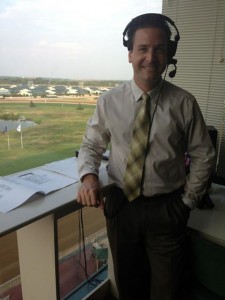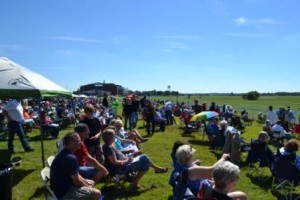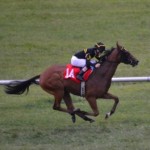Meet John Lies – A Comforting Track Announcer
In a previous article we introduced you to the very unique experience of Kentucky Downs racetrack in Franklin, Kentucky. Click here to read that article.
One of the details not included in that article was the pleasure of hearing the track announcer John Lies (pronounced Lees) perform a different style of announcing (or commentating as he likes to call it). With a manner that is both comforting and informative to the listener, John impressed me enough to make a mental note to get to know him better at some future point. With the help of C.J. Johnsen, I made contact with John and render the following interview.
It seems like you have a genuine interest in educating people. Is that your own style and is it unique to Kentucky Downs?
I do aim to do that. And that is something that is more my style than being specific to any racetrack. I take my act to whatever venue we’re at. I do some things similar at Lone Star Park [John is the full-time track announcer at Lone Star], but not identical. At Lone Star we have a paddock presenter, Dave Appleton … just like you heard Gary West doing at Kentucky Downs. I do a pre-race handicapping seminar here at Lone Star that does go out on the simulcast, but then nothing in between the races. [At Kentucky Downs John makes comments in between races about the upcoming race and interacts with Gary in a conversation style.]
At Del Mar for five years I was their simulcast track host, you know from the paddock and everything that comes with that presentation.
It’s really fulfilling for me to hear you say that, because it’s a lifetime of passion. And I feel very fortunate to do what I do for a living, and to have the jobs that I’ve had. I feel like I lead a very charmed life; to get to travel and experience different racetracks. And it makes me feel really good that sharing that with others is actually educating them.
I was very impressed how you were able to explain things in simple terms that people can understand. How and why do you do that?
Sometimes we (handicappers and horseplayers) can complicate things or overdo it. The last two seasons at Del Mar they’ve had me do selections in the program; write up 1-2-3 picks for each race and put a couple of sentences about each horse. They asked me to word it in such a way that the most casual San Diego native, that maybe never comes to the races, will know exactly what you’re talking about.
That’s been an interesting challenge, and I think it’s helped me do what you noticed, sum things up and put it in simple terms that everybody can understand. Instead of trying to demonstrate as much insider “shop” talk as possible. That can defeat the purpose a bit and maybe even turn off the audience that you’re talking to. What can be more effective is to put things into simple terms that people can understand. For example, when describing a horse’s problems breaking in a prior race, saying “He was the cause of his own trouble.” There’s a few words right there, instead of going on for five minutes about it.
Can you talk about the differences between Kentucky Downs and Lone Star Park?
Lone Star Park has been around since 1997. It’s a very young track. The audience I’m speaking to before the races is a very basic crowd. It’s not that they can’t grasp it and get it … they will pick it up.
Kentucky Downs has a special charm. It is a unique place in the United States. Not only the course, with the undulations and odd shape … but also the fans that go there as well. It’s very different than the folks going out on Kentucky Derby day. It’s a little bit more the county fair crowd, but in a high class turf setting … when you look at the caliber of the horses running and the money they were running for.
I think a lot of horses really respond to it as well. They feel like they’re out on a farm when you take them there. Everybody has to van in of course as there is no year round stabling. When they get there it’s all green, and I think they respond to that. Especially when the weather gets cooler like it was on several of the days. They’re happy horses, and they perform their best as a result of it. We had some exceptional racing this year, we really did. I was glad to be a part of it.
How much do you have to adjust your game at Kentucky Downs versus Lone Star Park?
The perspective that I’m calling from is the main thing. Most of the sprint races I’m getting a view of the back of the starting gate and watching the horses run away from me. The angle makes it very difficult to judge for that first 1/8 of a mile until they come down and start taking that turn. And once they come into the stretch they’re coming straight at you. You have this wall of horses that you need to sort out. It presents this unique challenge of judging the horses through your binoculars.
I also don’t have the aid of a television monitor that some guys might from different angles because it’s on several seconds delay from the way they send their live signal. So, I have to do it live through the binoculars.
Does it force you to alter your game in calling the race?
Not a lot, it’s just a higher level of difficulty. I still end up doing the same things I always do, which is reading the race and trying to pick up on the race shape. That can include the pace, the tempo, which jockeys look like they’re riding their horse conservatively as though they have a lot of horse and they’re saving him for the stretch run, or which jockey seems to be running out of horse on the turn. If they have to go to the whip early on the turn, I know they have virtually no shot, because it’s a long run in the stretch. When they straighten away they still have a quarter of a mile to go. So, I am looking at those things, yet I’m always looking for those things.
I’m looking at the horses and their body language. I’m looking at a horse’s head and their ears, how comfortably they may be running, whether or not they are fully extended or fully exerted at an early point in a race, which would obviously be a bad sign.
I’m also looking at the jockeys and their body language; that tells me a lot. I’m looking at a jockey’s hands. How high up on the horse’s neck are his hands? If they still have their hands low then the horse is doing things well within himself. He’s not asking him for anything yet. When their hands start to go higher up on a horse’s neck and they’re starting to scrub or actually ride the horse, then I know they’re probably running out of horse. It helps to know the individual jockeys and what their body language looks like and what that typically means for a certain rider.
It’s the same at all tracks, but at Kentucky Downs it’s just a little more difficult to decipher at different angles, and certainly when they’re coming down the stretch.
Are there any current or former track announcers you’ve modeled yourself after?
Trevor Denman is the man. His influence on me has been profound. The back story for me is, at the age of 10, I had the opportunity to meet Trevor at Del Mar. That was as nervous as I ever remember being in my young life, or perhaps ever. Trevor was someone I looked up to so much. When he started in 1984, I found myself turning down the volume on the television when the nightly replays showed, and calling the races off the TV as Trevor. Using his style, with his accent, actually mimicking him and using the stock things he says, like “moving like a winner” and “they would need to sprout wings.”
From my meeting I remember he did not treat me like a child. He asked me to call a race to him off the television replay. I’ll never forget that and I was absolutely blown away. It solidified for me at a young age that’s exactly what I wanted to do and I wanted to be just like him when I grew up.
Of course when I got older I knew you can’t be Trevor. You can’t use his accent or imitate him, you have to be you. I have to be John Lies and develop my own style. So, fast forward to today. I learned the basic blueprints and how I think you should approach calling a race from Trevor. But, I do it in my own voice, in my own style, in my own character … using the words I would use to describe things. But, all of the things I told you I’m looking for in a race and the blueprint on how to call a race … that is straight from Trevor. I would call myself a commentator, versus a chart caller. That’s a difference in style, especially in the United States.
In Part 2 of this interview, we’ll get into what John thinks is important when he’s calling a race, his background in the horse racing industry, and how it helped lead him to his present “charmed” life. Click here to read Part 2 of our interview.




